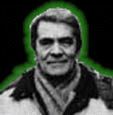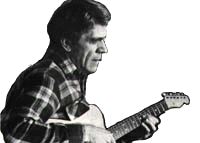
To hear Ed Bickert at his best, click here (RealAudio).

For those of you who believe you are familiar with the history of jazz guitar, and are not familiar with the music of Ed Bickert, it's time for a re-evaluation. Though he has achieved a certain amount of fame from his recordings with Paul Desmond, Milt Jackson, Oscar Peterson, and Stanley Turrentine, Ed is still generally unrecognized as a master within his genre, absolutely unsurpassed in harmonic subtlty, and sympathetic accompaniment. One of the many charms about Ed Bickert is that he can be enjoyed by so many different people, on so many different levels. The audience at an Ed Bickert performance is always widely varied, from older couples, to younger musicians and students. Many elder admirers appreciate Ed's music because his repetoire envokes nostalgia; his tune selections are invariably under-recorded and often unknown pieces from the songbooks of Jimmy VanHeusen, Cole Porter, George Gershwin, and other legendary songwriters. His wealth of knowledge regarding tunes is so vast that I've rarely heard him play the same selection twice in all the times I've seen him live. One of the many charms about Ed Bickert is that he can be enjoyed by so many different people, on so many different levels. The audience at an Ed Bickert performance is always widely varied, from older couples, to younger musicians and students. Many elder admirers appreciate Ed's music because his repetoire envokes nostalgia; his tune selections are invariably under-recorded and often unknown pieces from the songbooks of Jimmy VanHeusen, Cole Porter, George Gershwin, and other legendary songwriters. His wealth of knowledge regarding tunes is so vast that I've rarely heard him play the same selection twice in all the times I've seen him live.Then, there are the middle-aged couples, often out for a night of quiet conversation, wine, and jazz. Ed offers them a very soothing, easily-accessible type of music. For the more ardent jazz fans, Ed provides music that is seemingly simple, yet decievingly complex, an emalgamation of swing and bop-based lines, tonisization, moving inner voices, chord substitution (listen to the audio file of the example here), and more, always played with impeccable taste and restraint (Although there are recordings of Ed playing in a more aggressive context. Click here to listen to a RealAudio file of Ed playing "What is This Thing Called Love?". If a guitarist exists (or has existed) with a stronger command of "chordal playing" than Ed Bickert, I am not aware of him. Beginning the process of transcribing some of Ed's material for the Central Park North site, I was immediately struck by his ability to imply 4, 5, or 6 part chords with 3 note voicings. Repeated listenings were taken to certain passages, in an attempt to find that non-existent 4th note in each chord. Many of Ed's voicings are tricky to play, and can only be played in one particular area of the neck, on 1 string group, in order to be logistically possible. At the heart of Ed's style is one of jazz' fundamental concepts; tension and release. I imagine there are those who would listen to Bickert and announce that much of his music is without tension, and I could understand their misguided notion. So adept is Ed in his harmonic command, that he resolves much of the tension he creates before people realize there was any dissonance in the first place. Entire courses in music schools could be devoted to his use of passing chords, contrary motion, and deceptive resolution in his chord solos. Ed Bickert 1O1. It would be a class that just about every guitar player alive could benefit from. Many of the voicings Ed uses just don't get used by a lot of other guitarists. Some voicings I've heard Ed play I've only ever heard elsewhere in the music of fellow Canadian Lenny Breau. In an age where, 40 years after Wes Montgomery, most guitarists who play "chord solos" still resort to using his block-chord type voicings, it is wonderful to hear someone take the artform to another level. Ed Bickert 1O1. I like that. Where do I sign up? To see a complete transcription of an Ed Bickert solo, click here. To listen to Ed's solo on "A Handful of Stars" from his album "I Wished on The Moon", click here (RealAudio). Click here to go to Music Boulevard for further album information, with the option of buying "I Wished on The Moon" online. Click here to go to Music Boulevard for further album information on Paul Desmond's "Pure Desmond", with the option of buying this CD online.
Click here to go to the DSM Records website to read the liner notes to Ed Bickert's excellent double CD "The Guitar Mastery of Ed Bickert", and then here if you are interested in buying the CD online.
|